PLANT NATIVE GROUND COVERS & MAKE AMERICA GREEN AGAIN
When I think about making America green again, I dream of filling in all those stark areas of unnaturally dyed mulch. I fantasize about less lawn, too. But what my eco-tinted goggles really see is a decrease in the commonly planted ground covers like English ivy, Pachysandra and periwinkle. For although these ground-huggers are undeniably popular, we know that doesn’t mean they’re good choices for our gardens.
Excessively planted because of their uniformity, state of perpetual greenness, and alleged low maintenance, English ivy and its cronies have wreaked havoc across North America. They are not beneficial to wildlife—unless their propensity to harbor rats and help breed mosquitoes counts as critter friendly.
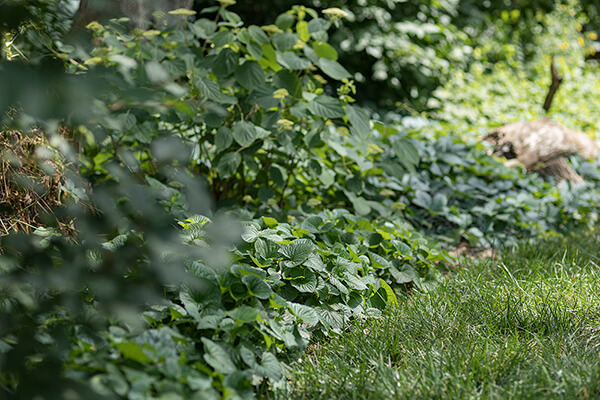
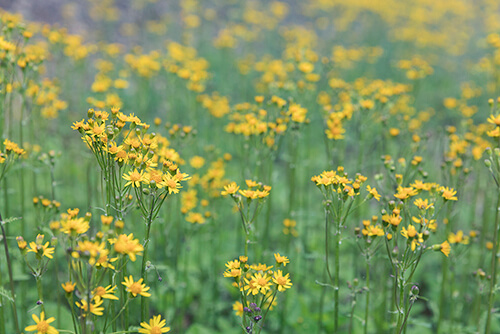
Why do we plant ground covers?
These are some common reasons why we choose ground covers:
√ aesthetics
√ erosion control
√ lower maintenance
√ weed suppression
√ wildlife habitat
You’ll find that the following native plants can satisfy most, if not all, of your ground-covering gardening objectives. Read on to learn what would work best for you.
But first! A note about erosion control:
Are you searching for stabilization on a slope? Think big. Think trees! Trees, with their amazing root systems, are considered by ecologists as the best choice for erosion control. Additionally, tree canopies will slow down heavy rains and help reduce stormwater runoff. There are oodles of other benefits that trees provide. And locally native trees are the best choice, naturally.
12 NOTABLE NATIVE GROUND COVERS
COMMON WILD GINGER, CANADIAN WILD GINGER
(ASARUM CANADENSE)
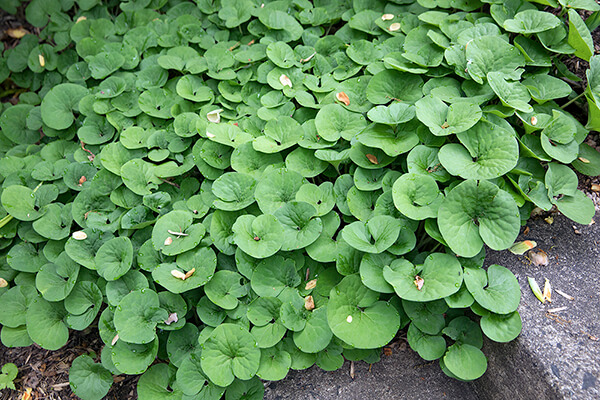
Aggressiveness: Low
Light Requirement: Part Shade, Shade
Soil Moisture: Moist
Natural Habitat: “Rich, mesic to dry-mesic upland forests and well-drained floodplain forests.”*
Comments: A deciduous plant with fun-shaped leaves and an attractive, dense habit, wild ginger is perfect for the moist shade garden. It spreads by rhizomes in ideal conditions. Wild ginger needs well-drained, rich soil; planting it in heavy clay may shorten its life. In spring the inconspicuous reddish flowers bloom underneath the foliage. Take a peek for a lovely surprise.
Host Plant Info: There is debate as to whether or not Asarum canadense is host to the pretty pipevine swallowtail butterfly. Doug Tallamy’s research indicates it is not.
More Information: Virginia Native Plant Society’s 2010 Wildflower of the Year; USDA Forest Service Wildflower Plant of the Week
GREEN-AND-GOLD (CHRYSOGONUM VIRGINIANUM)
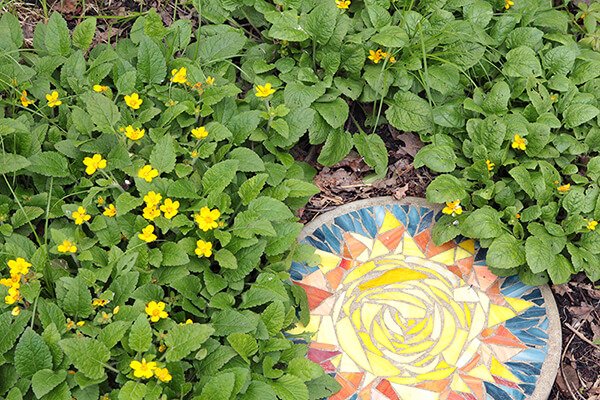
Aggressiveness: Low
Light Requirement: Part Shade
Soil Moisture: Moist, Dry
Natural Habitat: “Mesic to dry upland forests and woodlands; usually in moderately to strongly base-rich soils.”*
Comments: Against bright green foliage, pretty yellow flowers bloom in the spring and sporadically until summer. The clumping forms do not remain static in my garden and I often read the recommendation to plant densely then divide and move them every few years. Green-and-gold spreads by rhizomes in optimum conditions which include well-drained soils. It isn’t a plant that our white-tailed deer normally find delicious.
Host Plant Info: None known.
More Information: Master Gardeners of Northern Virginia; Virginia Native Plant Society-Jefferson Chapter
EASTERN HAY-SCENTED FERN (DENNSTAEDTIA PUNCTILOBULA)

Aggressiveness: High
Light Requirement: Part Shade, Shade
Soil Moisture: Moist, Dry
Natural Habitat: “Mesic to dry forests and woodlands, rock outcrops, pastures, clearings, and road banks.”*
Comments: Although I haven’t personally grown hay-scented fern, I know how beautiful it is from my visits to Shenandoah National Park. In Big Meadows, this deciduous fern is found in woodlands spreading far and wide in large colonies. It grows 1-3 feet, creeps by rhizomes and is considered aggressive by some growers. It’s perfect for wildlife cover.
Host Plant Info: Host to three Lepidoptera (butterfly and moth) species.
More Information: Master Gardeners of Northern Virginia; Connecticut Botanical Society
WHITE WOOD ASTER (EURYBIA DIVARICATA)
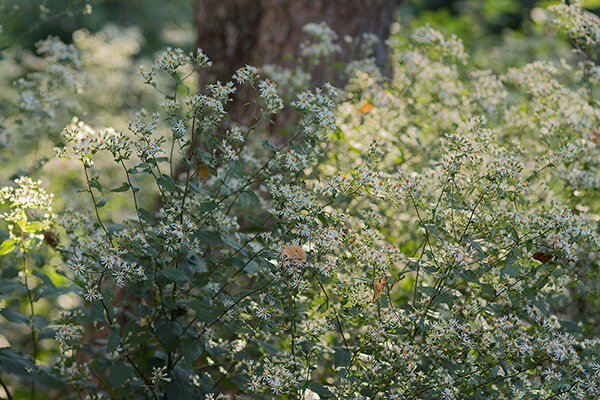
Aggressiveness: High
Light Requirement: Part Shade, Shade
Soil Moisture: Moist, Dry
Natural Habitat: “Mesic to dry upland forests, woodlands, shaded outcrops, well-drained floodplain forests, seepage swamps, and fens.”*
Comments: White wood aster is the tallest growing of all the flowering plants listed here and it’s one of my favorites because of how resilient and handsome it is. This woodland resident grows up to three feet—however my Northern Virginia ecotypes top out at about two feet. With dark green leaves and dainty white flowers, this plant practically glows in the shade when it blooms in late summer. It does just fine in dry shade. Asters are known to be aggressive self sowers in garden conditions; Eurybia divaricata is no exception and it also spreads by rhizomes. The dainty masses of flowers attract tiny insects.
Host Plant Info: None known.
More Information: Master Gardeners of Northern Virginia
WILD STRAWBERRY (FRAGARIA VIRGINIANA)
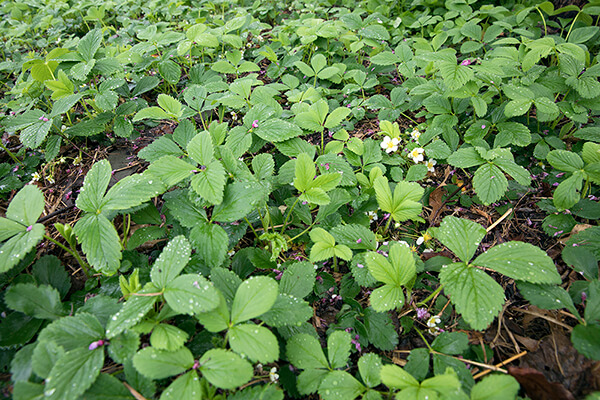
Aggressiveness: Low to Medium
Light Requirement: Sun, Part Shade, Shade
Soil Moisture: Moist, Dry
Natural Habitat: “Mesic to dry upland forests, woodlands, and well-drained alluvial forests; more characteristic of old fields, clearings, meadows, pastures, roadsides, and other open, disturbed habitats.”*
Comments: Wild strawberry is a wonderful, underused perennial plant that spreads quickly by runners in shade or sun. However, I don’t find it aggressive because it doesn’t outcompete other plants. The tiny white flowers bloom in spring and the fruit develops a short time later. Although small, the fruit is deliciously edible and is enjoyed by many of our wild creatures. The foliage is browsed by white-tailed deer with little detriment to this vigorous plant. Fragaria virginiana is not the weed you typically find in your garden or lawn. This species is undeniably more special: it was hybridized with a South American variety to produce the cultivated grocery store fruit we know and enjoy.
Host Plant Info: Supports Mid-Atlantic native bee pollen specialist Andrena melanochroa; also host to at least 75 Lepidoptera caterpillars including the gray hairstreak butterfly and the grizzled skipper.
More Information: Lake Forest College
GOLDEN RAGWORT, GOLDEN GROUNDSEL (PACKERA AUREA)
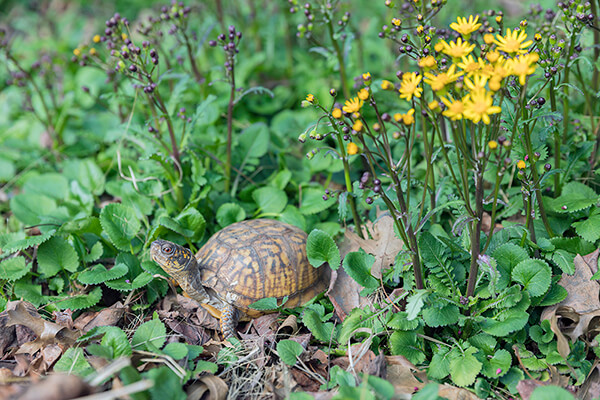
Aggressiveness: High
Light Requirement: Part Shade, Shade
Soil Moisture: Moist
Natural Habitat: “Floodplain forests, mesic to occasionally dry-mesic upland forests, seepage swamps, fens, seeps, stream banks, tidal swamps, and moist meadows; most frequent and numerous in moderately to strongly base-rich soils.”*
Comments: This is the native plant that is most commonly recommended as an alternative to English ivy in shady locations. The charming golden ragwort is evergreen and has long-blooming bright yellow flowers that sit high above the basal leaves in late March. I think it’s one of the showiest of the early bloomers. And it reseeds like the dickens. Golden ragwort self-sows so vigorously that you don’t have to install many plants initially. Be warned that it will outcompete most other herbaceous plants. My ragworts are growing in fairly shady conditions under a redbud tree and appear happy. I especially like that golden ragwort supports so many of our insects.
Host Plant Info: Supports Mid-Atlantic pollen specialist bee Andrena gardineri; host to 17 Lepidoptera species.
More Information: Master Gardeners of Northern Virginia
VIRGINIA CREEPER (PARTHENOCISSUS QUINQUEFOLIA)

Aggressiveness: High
Light Requirement: Sun, Part Shade, Shade
Soil Moisture: Wet, Moist, Dry
Natural Habitat: “Ubiquitous in an extraordinary range of wet to very dry, forested to open habitats; tolerant of a range of soil types, tolerant of deep flooding, capable of rooting in deep outcrop crevices and boulder-field interstices that exclude other plants; scarce at the highest elevations.”*
Comments: Virginia creeper is not for everyone or for everyone’s garden. I list this adaptable deciduous vine as a great ground cover because it rapidly carpets an area, provides hiding places for small critters, has beautiful foliage (especially in autumn), supports our sphinx moth caterpillars, and if allowed to climb, produces fruit in sync with fall migrating birds. I have it growing in dappled shade on the side of our property where I keep it in check by cutting back the vines periodically. It will rapidly clamber up and over everything including trees, shrubs and idle husbands. It climbs by tendrils with adhesive tips so it doesn’t need support and as another attribute, Virginia creeper does not damage walls. Note that the fruit is highly toxic when eaten by people. Deer and rabbits browse the foliage—but there never seems to be a shortage of leaves.
Host Plant Info: Host to at least 32 different species of butterfly and moth caterpillars including our delightful hummingbird moths.
More Information: Maryland Native Plant Society’s Wildflower in Focus; Virginia Tech Dept. of Forest Resources & Environmental Conservation
DWARF CINQUEFOIL (POTENTILLA CANADENSIS)

Aggressiveness: High
Light Requirement: Sun, Part Shade
Soil Moisture: Moist, Dry
Natural Habitat: “Dry-mesic to dry forests, woodlands, barrens, clearings, fields, and roadsides.”*
Comments: The perennial dwarf cinquefoil is a low-growing, uncommon garden plant that definitely should be planted more. Its dainty yellow flowers bloom from spring through early summer and attract our native bees and other insects. Happy in poor soil, dwarf cinquefoil spreads relatively quickly by runners. It will creep into lawn. It’s an attractive ground cover that works well at the feet of taller plants. I’ve also added it to my planters since it cascades out of the containers nicely.
Host Plant Info: Supports Mid-Atlantic native bee pollen specialists Andrena ziziaeformis & Panurginus potentillae; hosts 14 native butterfly and moth caterpillars including the grizzled skipper.
More Information: Sky Meadows Nature Guide; NC State Extension
LYRELEAF SAGE (SALVIA LYRATA)
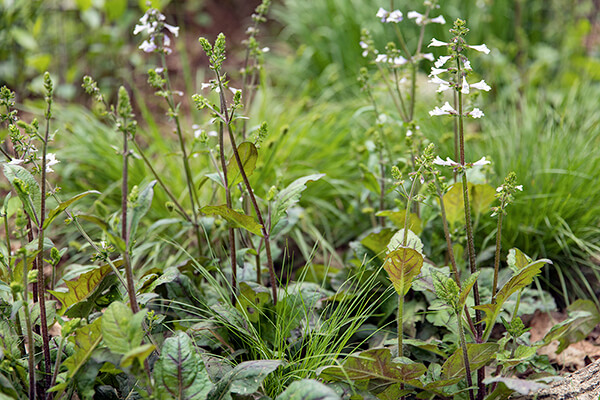
Aggressiveness: High
Light Requirement: Sun, Part Shade, Shade
Soil Moisture: Moist, Dry
Natural Habitat: “Lawns, fields, roadsides, clearings, mesic to dry forests and woodlands, well-drained floodplain forests, limestone and dolomite barrens.”*
Comments: Lyreleaf sage is adaptable to a lot of varying conditions. It tolerates periodic flooding as well as drought; note that it’ll want more shade in dry soils. The typically blueish or lavender tubular flowers attract our amazing hummingbirds and insects in spring. The large basal leaves are tinged with purple. Lyreleaf sage is also a prolific self-sower; I’ve observed it competing successfully with weeds in mowed hell strips. Allowing the seeds to ripen will attract American goldfinches and other birds.
Host Plant Info: Supports five butterfly and moth caterpillar species.
More Information: Virginia Wildflowers; Maryland Biodiversity Project; VNPS Lyre-leaf Sage
WILD STONECROP (SEDUM TERNATUM)

Aggressiveness: Medium
Light Requirement: Part Shade, Shade
Soil Moisture: Moist, Dry
Natural Habitat: “Well-drained floodplain forests, mesic upland forests, shaded ledges and outcrops; usually, but not always, in base-rich soils.”*
Comments: Wild stonecrop—the rock garden rock star. It’s a creeping succulent perennial with tiny semi-evergreen or evergreen leaves. The starry white flowers that appear in spring brighten the garden and add much interest. I’ve come across wild stonecrop growing on sloped woods with Pennsylvania sedge (Carex pensylvanica) and although it was not a dense growth, it was nonetheless enchanting. I like Sedum ternatum because in a garden setting it spreads at a good pace and is easy to lift and relocate to other areas. The stems also root easily.
Host Plant Info: Known as a host plant for four native caterpillars.
More Information: Master Gardeners of Northern Virginia
HEARTLEAF FOAMFLOWER (TIARELLA CORDIFOLIA)
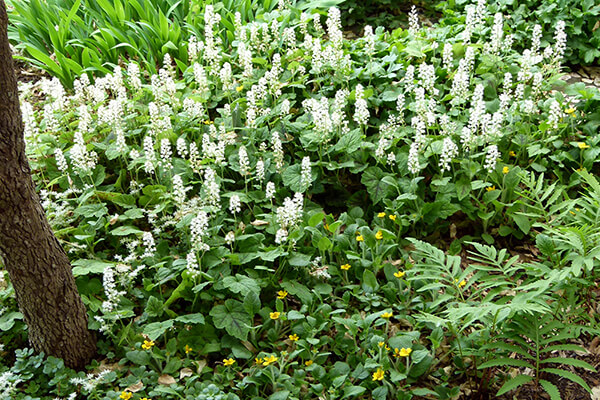
Photo by Sue Dingwell.
Aggressiveness: Low – Medium
Light Requirement: Part Shade, Shade
Soil Moisture: Moist
Natural Habitat: “Overall the species occurs in cove forests, mesic to dry-mesic slope forests, well-drained alluvial forests, and crevices of shaded rock outcrops. It favors, but is not restricted to, more base-rich soils.”*
Comments: Frothy spikes of white and pinkish flowers are one of the reasons to plant foamflower. Low growing, it spreads by stolons and forms colonies over time. Insects are attracted to the flowers. This is another ideal plant for a woodland setting or the shady garden.
Host Plant Info: None known.
More Information: Master Gardeners of Northern Virginia; Wildflowers of the United States
COMMON BLUE VIOLET (VIOLA SORORIA)
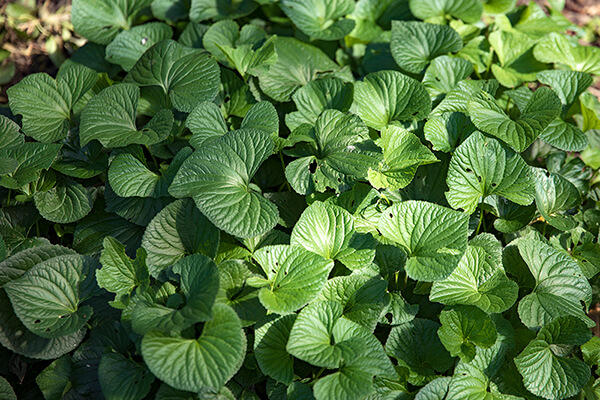
Aggressiveness: High
Light Requirement: Sun, Part Shade
Soil Moisture: Moist, Dry
Natural habitat: “In an extremely wide range of forested to open, natural to ruderal habitats. Its natural habitats include swamp hummocks, floodplain forests, and varied mesic to dry upland forests. It can also be abundantly weedy in lawns, fields, pastures, and many other disturbed habitats.”*
Comments: Our common violet is rarely mentioned as a grand groundcover by commercial growers—perhaps because it’s typically found growing in our gardens for free. Yes, it’s a little weedy and ordinary, but why not enjoy its wildlife value, lovely foliage, pretty springtime violet flowers and its willingness to reseed rampantly? Plus you can’t beat the price! Consider not growing it on the edge of a pristine lawn if you aren’t willing to hand pull the volunteers. All parts of Viola sororia are edible.
Host Plant Info: Supports Mid-Atlantic native bee pollen specialist Andrena violae; host to at least 27 butterfly and moth caterpillars.
For More Information: The Friends of the Wild Flower Garden, Inc.; Xerces Society Plants for Pollinators: Violets
*Natural habitat information provided by the Digital Atlas of the Virginia Flora
More Options!
There are many other native beauties that can be used as ground covers to help improve this land of ours. New York fern (Thelypteris noveboracensis), Sensitive fern (Onoclea sensibilis), Wild geranium (Geranium maculatum), Blue mistflower (Conoclinium coelestinum), American alumroot (Heuchera americana), Dwarf crested iris (Iris cristata), Creeping phlox (Phlox stolonifera), Golden alexanders (Zizia aurea), Starry solomon’s plume (Maianthemum stellatum), Carolina elephant’s-foot (Elephantopus carolinianus), Robin’s plantain (Erigeron pulchellus) … the list is long.
Many of these plants, as I’ve noted, can spread quickly through self-sowing or through stolons or rhizomes. This is what makes them excellent ground covers—but could also cause unwanted upkeep. Definitely do the research so you aren’t cursing me later.
Feel free to browse the following ground cover articles for more ideas and information. Don’t forget to choose plant species native to your region—and purchase local ecotypes whenever possible.
♥ The Humane Gardener: Dracula’s Garden: 3 Great Groundcovers
♥ Virginia Native Plant Society: Native Alternatives to English Ivy
♥ Master Gardeners of Northern Virginia: Tried & True Ground Covers
♥ Prince William Wildflower Society: Wildflowers for Woodland Gardens
♥ Native Ground Covers of Western Pennsylvania for Lawn Alternatives (note that the Creeping Thyme is native to Europe)
♥ The Native Plant Society of New Jersey: Native Groundcovers
♥ North Jersey Resource Conservation & Development: Riparian Buffer
– NJRCD Native Ground Covers, Vines, and Herbaceous Perennials for Riparian Buffers in Northern New Jersey Watersheds
♥ Houzz: Native Alternatives to English Ivy, Japanese Pachysandra and Periwinkle
♥ GreenStrides: Great Native Ground Covers
Happy wildlife gardening!
Updated April 20, 2021
